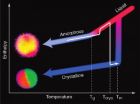(Press-News.org) The ability of phase-change materials to readily and swiftly transition between different phases has made them valuable as a low-power source of non-volatile or "flash" memory and data storage. Now an entire new class of phase-change materials has been discovered by researchers with the Lawrence Berkeley National Laboratory (Berkeley Lab) and the University of California (UC) Berkeley that could be applied to phase change random access memory (PCM) technologies and possibly optical data storage as well. The new phase-change materials – nanocrystal alloys of a metal and semiconductor – are called "BEANs," for binary eutectic-alloy nanostructures.
"Phase changes in BEANs, switching them from crystalline to amorphous and back to crystalline states, can be induced in a matter of nanoseconds by electrical current, laser light or a combination of both," says Daryl Chrzan, a physicist who holds joint appointments with Berkeley Lab's Materials Sciences Division and UC Berkeley's Department of Materials Science and Engineering. "Working with germanium tin nanoparticles embedded in silica as our initial BEANs, we were able to stabilize both the solid and amorphous phases and could tune the kinetics of switching between the two simply by altering the composition."
Chrzan is the corresponding author on a paper reporting the results of this research which has been published in the journal NanoLetters titled "Embedded Binary Eutectic Alloy Nanostructures: A New Class of Phase Change Materials."
Co-authoring the paper with Chrzan were Swanee Shin, Julian Guzman, Chun-Wei Yuan, Christopher Liao, Cosima Boswell-Koller, Peter Stone, Oscar Dubon, Andrew Minor, Masashi Watanabe, Jeffrey Beeman, Kin Yu, Joel Ager and Eugene Haller.
"What we have shown is that binary eutectic alloy nanostructures, such as quantum dots and nanowires, can serve as phase change materials," Chrzan says. "The key to the behavior we observed is the embedding of nanostructures within a matrix of nanoscale volumes. The presence of this nanostructure/matrix interface makes possible a rapid cooling that stabilizes the amorphous phase, and also enables us to tune the phase-change material's transformation kinetics."
A eutectic alloy is a metallic material that melts at the lowest possible temperature for its mix of constituents. The germanium tin compound is a eutectic alloy that has been considered by the investigators as a prototypical phase-change material because it can exist at room temperature in either a stable crystalline state or a metastable amorphous state. Chrzan and his colleagues found that when germanium tin nanocrystals were embedded within amorphous silica the nanocrystals formed a bilobed nanostructure that was half crystalline metallic and half crystalline semiconductor.
"Rapid cooling following pulsed laser melting stabilizes a metastable, amorphous, compositionally mixed phase state at room temperature, while moderate heating followed by slower cooling returns the nanocrystals to their initial bilobed crystalline state," Chrzan says. "The silica acts as a small and very clean test tube that confines the nanostructures so that the properties of the BEAN/silica interface are able to dictate the unique phase-change properties."
While they have not yet directly characterized the electronic transport properties of the bilobed and amorphous BEAN structures, from studies on related systems Chrzan and his colleagues expect that the transport as well as the optical properties of these two structures will be substantially different and that these difference will be tunable through composition alterations.
"In the amorphous alloyed state, we expect the BEAN to display normal, metallic conductivity," Chrzan says. "In the bilobed state, the BEAN will include one or more Schottky barriers that can be made to function as a diode. For purposes of data storage, the metallic conduction could signify a zero and a Schottky barrier could signify behavior a one."
Chrzan and his colleagues are now investigating whether BEANs can sustain repeated phase-changes and whether the switching back and forth between the bilobed and amorphous structures can be incorporated into a wire geometry. They also want to model the flow of energy in the system and then use this modeling to tailor the light/current pulses for optimum phase-change properties.
INFORMATION:
The in-situ Transmission electron microscopy characterizations of the BEAN structures were carried out at Berkeley Lab's National Center for Electron Microscopy, one of the world's premier centers for electron microscopy and microcharacterization.
Berkeley Lab is a U.S. Department of Energy (DOE) national laboratory located in Berkeley, California. It conducts unclassified scientific research and is managed by the University of California for the DOE Office of Science. Visit our Website at http://www.lbl.gov.
Magical BEANs: New nano-sized particles could provide mega-sized data storage
2010-09-17
ELSE PRESS RELEASES FROM THIS DATE:
Do the math, say UCLA researchers
2010-09-17
In 2008, Reuben Granich and his colleagues at the World Health Organization published a paper in the medical journal The Lancet that proposed a new strategy for combating HIV in South Africa, a country staggered by the virus, with as much as 18 percent of the population estimated to be infected.
Based on a mathematical model, the study suggested a "test-and-treat" strategy. This would involve, among other steps, testing the entire population of South Africa for HIV and immediately beginning anti-retroviral therapy for all who tested positive. The current standard of ...
UCLA physicists control chemical reactions mechanically
2010-09-17
UCLA physicists have taken a significant step in controlling chemical reactions mechanically, an important advance in nanotechnology, UCLA physics professor Giovanni Zocchi and colleagues report.
Chemical reactions in the cell are catalyzed by enzymes, which are protein molecules that speed up reactions. Each protein catalyzes a specific reaction. In a chemical reaction, two molecules collide and exchange atoms; the enzyme is the third party, the "midwife to the reaction."
But the molecules have to collide in a certain way for the reaction to occur. The enzyme binds ...
Asian 'unicorn' photographed for first time in over 10 years
2010-09-17
For the first time in more than ten years, there has been a confirmed sighting of one of the rarest and most mysterious animals in the world, the saola of Laos and Vietnam. The Government of the Lao People's Democratic Republic (also known as Laos) announced on September15 that in late August villagers in the central province of Bolikhamxay captured a saola and brought it back to their village. The animal died several days later, but was photographed while still alive.
This is the first confirmed record of the species since two photographs of wild saola were taken ...
Standardized violence-prevention programs may not prevent teen fighting, findings suggest
2010-09-17
DALLAS – Sept. 17, 2010 – UT Southwestern Medical Center investigators have uncovered new insights on adolescent fighting: what triggers it, and how to stem it.
Varied real-life factors pile on daily to put teens on edge: destructive behaviors like drug abuse, drinking or high-risk sexual encounters; poverty; academic troubles; and even depression. Data analyzed by researchers at UT Southwestern suggests that when teens perceive support from their families and/or schools, it can help mitigate violence.
"Our findings tell us that it's unlikely that traditional cookie-cutter ...
Less is more in the fight against terrorism
2010-09-17
Terrorist networks are complex. Now, a mathematical analysis of their properties published this month in the International Journal of Networking and Virtual Organisations, suggests that the best way to fight them is to isolate the hubs within the network rather than trying to destroy the network as a whole through short-term battles.
According to Philip Vos Fellman a Lecturer at Suffolk University, Boston, and member of the New England Complex Systems Institute, USA, tools used to analyze complex systems can also be used to study terrorist networks with a view to undermining ...
Research could improve detection of liver damage
2010-09-17
LIVERPOOL, UK – 17 September 2010: Research at the University of Liverpool could lead to faster and more accurate diagnoses of liver damage.
The team used paracetamol as the basis for the study: research indicates that paracetamol can place temporary stress on the liver in around a third of people who take a normal dose (4g per day) but the liver returns to normal when the drug has left the system. Overdoses of the drug are a major cause of liver failure in both the UK and US.
Scientists have discovered that the presence of specific proteins in the blood are indicative ...
Teenagers are more sedentary on weekends
2010-09-17
"A sedentary lifestyle has become one of the major public health problems in developed countries", Juan P. Rey-López, lead author of the study and a researcher at the University of Zaragoza (UNIZAR), tells SINC. "During the week, one-third of teenagers said the watched more than two hours of television per day. At weekends, this figure exceeds 60%".
The results, published in the July issue of the journal Preventive Medicine, show that teenagers devote more time to sedentary behaviour (in front of a screen) at the weekend.
The study, which forms part of the European ...
Light is the friend of lovers
2010-09-17
The increase of artificial night lighting is only one of the consequences of intense urbanization. There is no doubt that chemical and noise pollution can have a strong impact on ecosystems. To date, however, the more subtle consequences of light pollution on wild populations of animals have not received enough attention. Scientists of the Max Planck Institute for Ornithology have now shown that permanent night lighting alters the reproductive behaviour of birds. In those habitats that are affected by artificial light, males started to sing earlier and females advanced ...
At the crossroads of chromosomes
2010-09-17
PHILADELPHIA – On average, one hundred billion cells in the human body divide over the course of a day. Most of the time the body gets it right but sometimes, problems in cell replication can lead to abnormalities in chromosomes resulting in many types of disorders, from cancer to Down Syndrome.
Now, researchers at the University of Pennsylvania's School of Medicine have defined the structure of a key molecule that plays a central role in how DNA is duplicated and then moved correctly and equally into two daughter cells to produce two exact copies of the mother cell. ...
Emotional robot pets
2010-09-17
Designers of robot pets are fighting a never-ending battle with consumers to provide entertaining and realistic gadgets that respond to human interaction in ever more nuanced ways, mimicking the behavior of real pet animals or even people. Researchers in Taiwan are now looking at a new design paradigm that could see the development of a robot vision module that might one-day recognize human facial expressions and respond appropriately.
Part of the problem is that robot design takes a long time, while the consumer life cycle of any given product is very short. Moreover, ...




